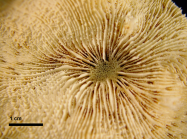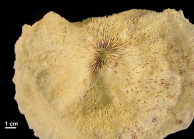WoRMS taxon details
Echinomorpha Veron, 2000
267403 (urn:lsid:marinespecies.org:taxname:267403)
accepted
Genus
Echinophyllia nishihirai Veron, 1990 accepted as Echinomorpha nishihirai (Veron, 1990) (type by original designation)
marine, fresh, terrestrial
Veron JEN. (2000). Corals of the World. Vol. 1–3. <em>Australian Institute of Marine Science and CRR, Queensland, Australia.</em> [details]
Description 'This genus has only one species, see Echinomorpha nishihirai.' (Veron, 2000, vol. 2: 333) For Echinomorpha nishihirai,...
Description 'This genus has only one species, see Echinomorpha nishihirai.' (Veron, 2000, vol. 2: 333) For Echinomorpha nishihirai, 'Characters: Colonies or individuals are thin and delicate. They may have only one corallite or have a prominent central corallite and widely spaced peripheral corallites. Septo-costae radiate from the central corallite like spokes from a wheel. Colour: Uniform or mottled dark browns or greens.' (Veron, 2000, vol. 2: 333) [details]
Hoeksema, B. W.; Cairns, S. (2024). World List of Scleractinia. Echinomorpha Veron, 2000. Accessed through: World Register of Marine Species at: https://www.marinespecies.org/aphia.php?p=taxdetails&id=267403 on 2024-04-26
Date
action
by
![]() The webpage text is licensed under a Creative Commons Attribution 4.0 License
The webpage text is licensed under a Creative Commons Attribution 4.0 License
original description
Veron JEN. (2000). Corals of the World. Vol. 1–3. <em>Australian Institute of Marine Science and CRR, Queensland, Australia.</em> [details]
context source (Hexacorallia) Fautin, Daphne G. (2013). Hexacorallians of the World. (look up in IMIS) [details]
basis of record van der Land, J. (ed). (2008). UNESCO-IOC Register of Marine Organisms (URMO). , available online at http://www.marinespecies.org/urmo/ [details]
additional source Budd AF, Fukami H, Smith ND, Knowlton N. (2012). Taxonomic classification of the reef coral family Mussidae (Cnidaria: Anthozoa: Scleractinia). <em>Zoological Journal of the Linnean Society.</em> 166 (3): 465-529., available online at https://doi.org/10.1111/j.1096-3642.2012.00855.x [details]
additional source Huang D, Arrigoni R, Benzoni F, Fukami H, Knowlton N, Smith ND, Stolarski J, Chou LM, Budd AF. (2016). Taxonomic classification of the reef coral family Lobophylliidae (Cnidaria: Anthozoa: Scleractinia). <em>Zoological Journal of the Linnean Society.</em> 178(3): 436-481., available online at https://doi.org/10.1111/zoj.12391 [details]
context source (Hexacorallia) Fautin, Daphne G. (2013). Hexacorallians of the World. (look up in IMIS) [details]
basis of record van der Land, J. (ed). (2008). UNESCO-IOC Register of Marine Organisms (URMO). , available online at http://www.marinespecies.org/urmo/ [details]
additional source Budd AF, Fukami H, Smith ND, Knowlton N. (2012). Taxonomic classification of the reef coral family Mussidae (Cnidaria: Anthozoa: Scleractinia). <em>Zoological Journal of the Linnean Society.</em> 166 (3): 465-529., available online at https://doi.org/10.1111/j.1096-3642.2012.00855.x [details]
additional source Huang D, Arrigoni R, Benzoni F, Fukami H, Knowlton N, Smith ND, Stolarski J, Chou LM, Budd AF. (2016). Taxonomic classification of the reef coral family Lobophylliidae (Cnidaria: Anthozoa: Scleractinia). <em>Zoological Journal of the Linnean Society.</em> 178(3): 436-481., available online at https://doi.org/10.1111/zoj.12391 [details]
 Present
Present  Inaccurate
Inaccurate  Introduced: alien
Introduced: alien  Containing type locality
Containing type locality
From editor or global species database
Comparison Echinomorpha possesses the autapomorphy of septa in ≥ four cycles (≥ 48 septa), and is unique among the closely related genera of Echinomorpha, Echinophyllia and Oxypora in subclade F, which generally have fewer septa. Subcorallite and genetic characters for Echinomorpha nishihirai have not been examined, but all the observed macromorphological traits suggest that it may be the sister species of Echinophyllia tarae, which differs only in having a raised central corallite rim and paliform crown, and lacking in the above autapomorphy (Benzoni, 2013). [details]Description 'This genus has only one species, see Echinomorpha nishihirai.' (Veron, 2000, vol. 2: 333) For Echinomorpha nishihirai, 'Characters: Colonies or individuals are thin and delicate. They may have only one corallite or have a prominent central corallite and widely spaced peripheral corallites. Septo-costae radiate from the central corallite like spokes from a wheel. Colour: Uniform or mottled dark browns or greens.' (Veron, 2000, vol. 2: 333) [details]
Diagnosis Colonial, but often solitary; laminar. Budding intracalicular. Corallites polymorphic; organically united and lacking distinct calical walls. Monticules absent. Coenosteum spinose; extensive amount (≥ corallite diameter). Calice width large (> 15 mm), with medium relief (3–6 mm). Costosepta mostly confluent in colonies. Septa in ≥ four cycles (≥ 48 septa). Free septa irregular. Septa spaced < six septa per 5 mm. Costosepta unequal in relative thickness. Columellae trabecular and spongy (> three threads), ≥ 1/4 of calice width, and discontinuous among adjacent corallites with lamellar linkage. Paliform (uniaxial) lobes weakly developed. Epitheca absent. Endotheca low-moderate (tabular). [details]
Remark Echinomorpha is a monotypic genus that was described recently (Veron, 2000, vol. 2: 333). Its sole member previously belonged to the closely-related Echinophyllia. Although no genetic material was available to place the genus on the molecular phylogeny, we analysed the macromorphological data for Echinomorpha nishihirai (Veron, 1990: 130). Our results show that it is nested within the Echinophyllia + Oxypora clade and is the sister taxon to Echinophyllia tarae Benzoni, 2013: 63. There is low support for the latter relationship, but the former is supported by a high bootstrap value of 71 and decay index of 4. Due to the sparse taxonomic sampling among Echinomorpha, Echinophyllia and Oxypora (subclade F + G sensu Arrigoni et al., 2014c) in this study, we refrain from prescribing formal changes for these taxa. Echinomorpha is restricted to the reefs of central Indo-Pacific between Japan and Indonesia (Veron, 2000). [details]
| Language | Name | |
|---|---|---|
| Japanese | オキナワキッカサンゴ属 | [details] |

